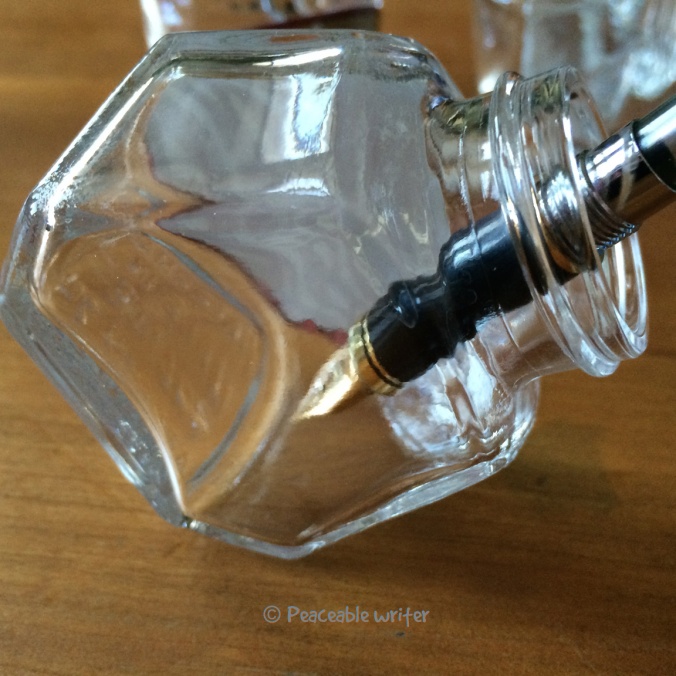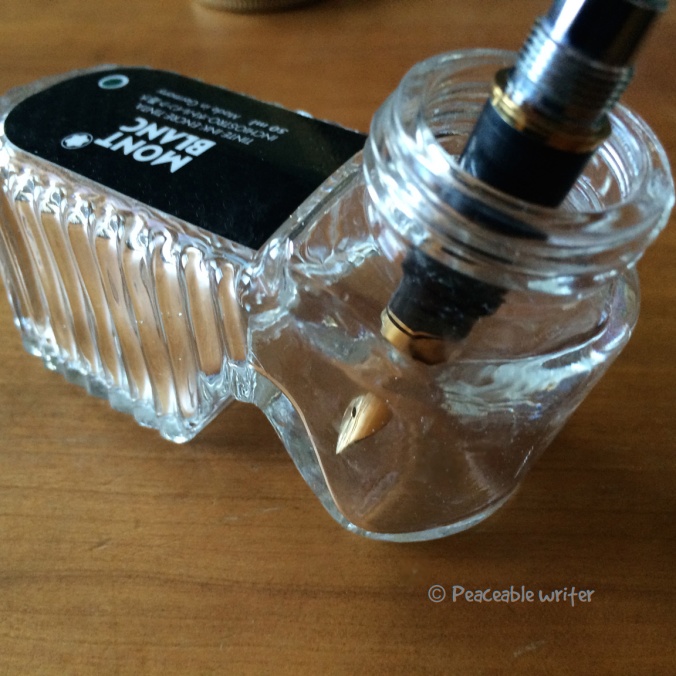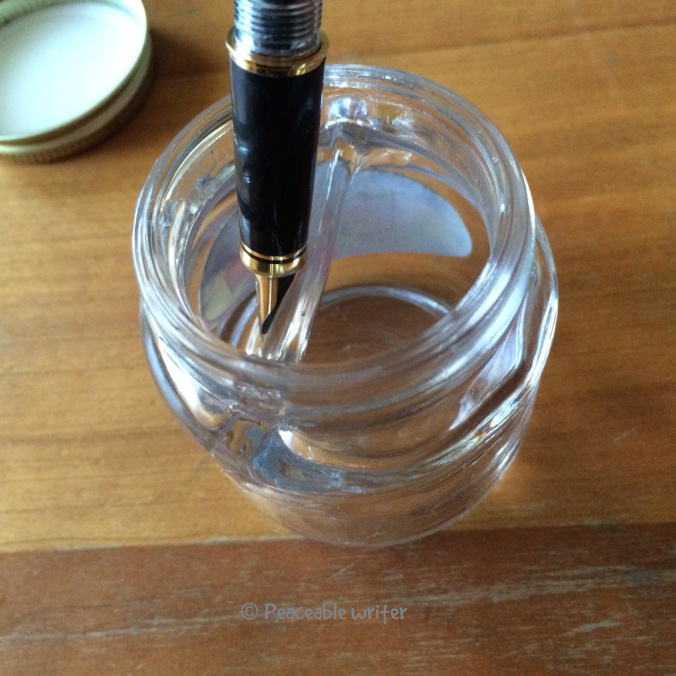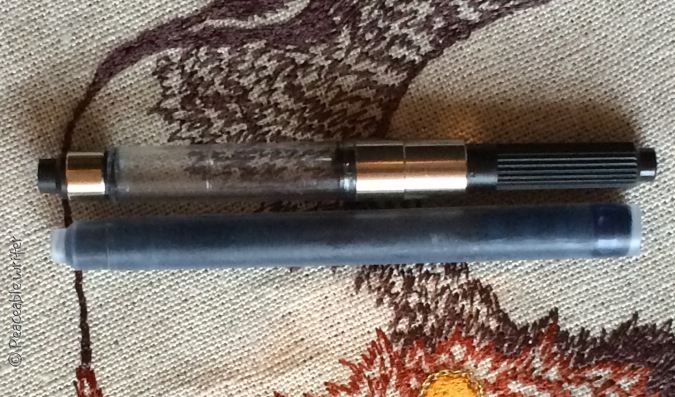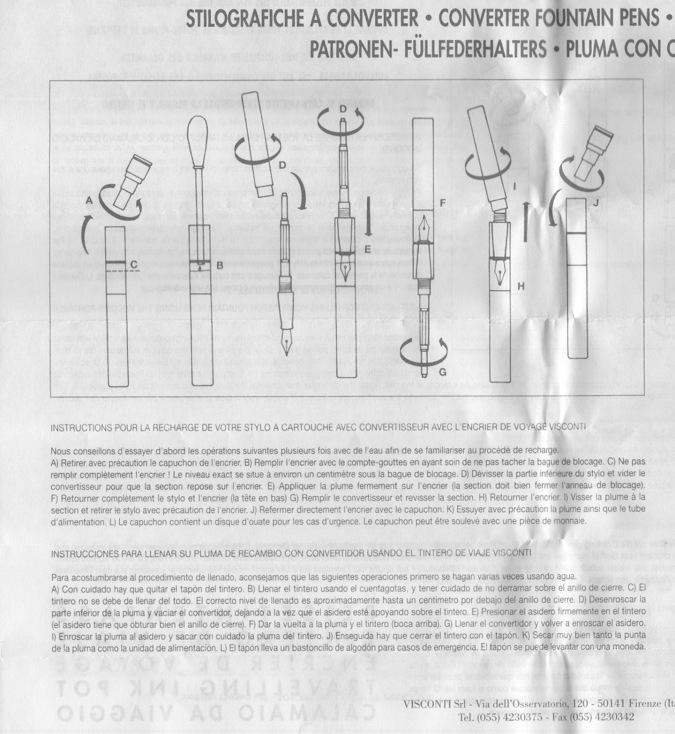While my main fountain pens hold a lot of ink as eyedroppers (3ml or more), cartridge/converter pens with tinier ink tanks get a lot of use this time of year.
Once upon a time, taking a converter-filled Pilot pen out and about for some letter writing, the pen ran out of ink very quickly. Alas, there was no ink on hand to refill it. Spoiled by my eyedropper pens, I’d forgotten to check the Pilot’s tiny ink supply. This minor life incident led me to consider options for carrying more ink for my converter pens.
My first thought was to reuse some very handy ink bottles. While most empty ink bottles go into my recycling bin, there are a very small number I’ve kept because they have good “after life” uses.
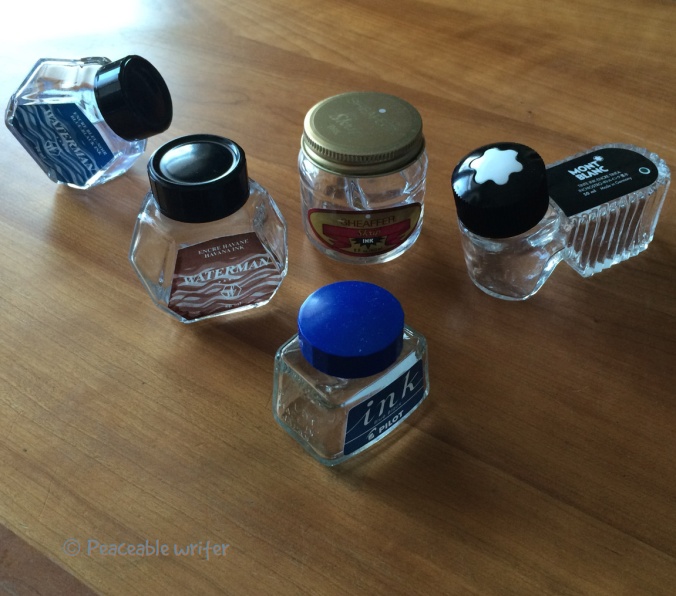
Left to right: Waterman, Sheaffer, Montblanc, Pilot (in front)
The Waterman and Montblanc empties are excellent inkwells. Because the Waterman bottles can be turned onto one of the sides, there’s no hassle filling nibs from them. Same can be said for the Montblanc bottle, with it’s slanted shape at the mouth.
The Sheaffer bottle I use for soaking nib units, when they need a more deeper cleaning. The division in the glass provides a nice shallow well for nibs to sit and soak. They’re easily removed, too.
The Pilot bottle has been used to carry small batches of Pilot Blue-Black, pouring from a large 350ML bottle into the smaller one.
Ultimately, glass bottles are great around the house-office, but a little clumsy to carry in the laptop bag. At the coffee house-office, the glass bottles can be a little conspicuous, and can cause perplexing fainting fits among barista managers.
Tiny Plastic Bottles
The next experiment concerned carrying extra ink in little vials, and even slightly larger nalgene bottles. These work fine, especially to carry in a laptop or tote bag. They’re kinda unbreakable, but the little plastic bottles prove more difficult to use when the ink runs low.
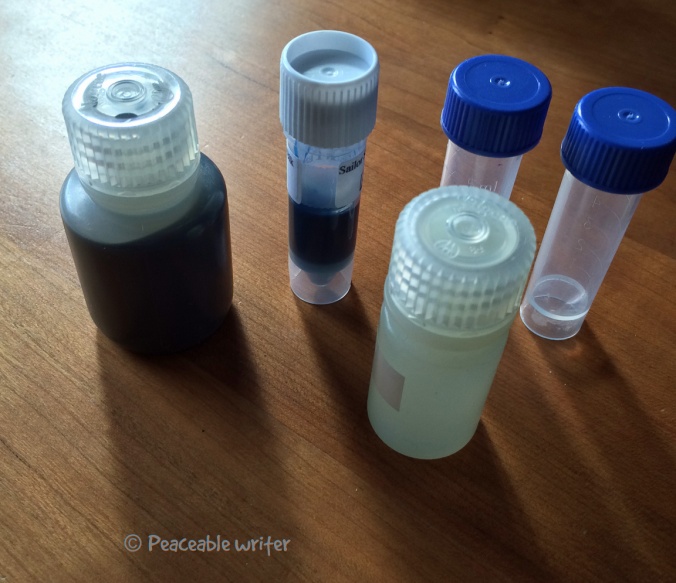
Portable ink bottles
Refilling Ink Cartridges
The next experiment involved ink cartridges. Carts were a more successful vehicle, and provided larger quantities of ink for a pen.
Carts are very convenient, but seem a wasteful use of plastic. Yet ink carts, too, can have an after life when they are emptied of ink. That is, you can re-ink them.
A lot of fountain pen users employ the practice of refilling ink cartridges with their favorite inks. I’ve ventured into cartridge re-filling for my Pilot pens (an MYU 701, Namiki Sterling, Pilot Decimo), my small Danitrio Cumlaude, and occasionally an Edison pen.
The Pilots require a proprietary Pilot/Namiki ink cartridge. Using a cartridge, the MYU holds more ink than the Con-50 converter I normally use.
- Pilot/Namiki Ink Cartridge .9ml (pretty good!)
- Pilot Con-50 .6ml
- Pilot Con-20 .8ml (a squeeze converter)
- Pilot Con-70 1ml (none of my Pilots can use the Con-70)
When brand new, the Pilot/Namiki ink cartridge comes sealed with a plastic disc. When you install the cartridge in your pen, the disc gets shoved into the cartridge. Some people remove this. I leave it alone. Call me lazy busy.
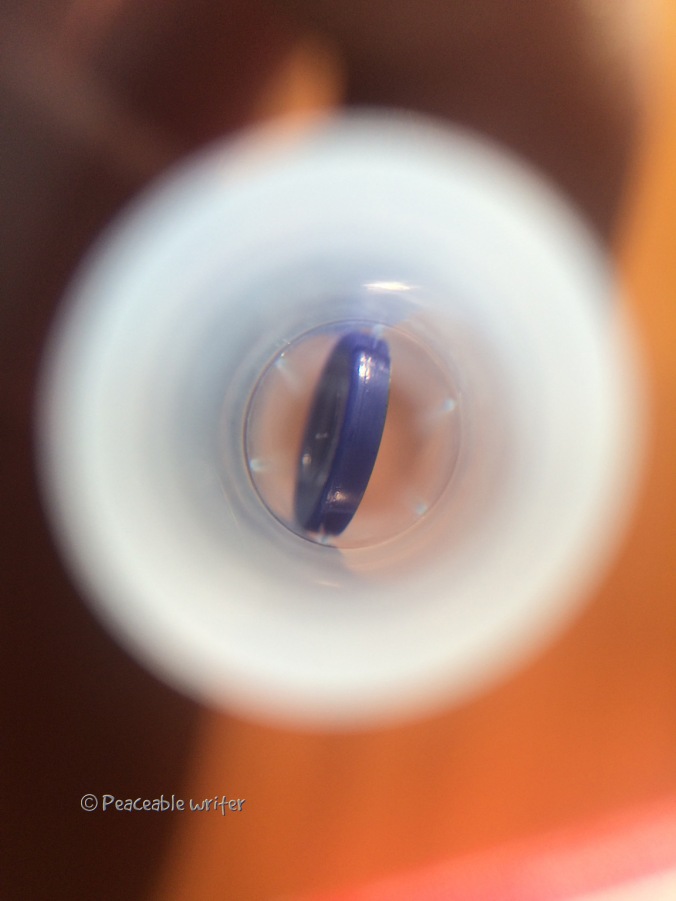
plastic disc inside Pilot/Namiki cartridge
My small Danitrio Cumlaude came with a tiny slide converter which holds very little ink. Predominately, I’ve used the Cumlaude in eyedropper mode (ED). Sometimes I like to use the pen with a little less ink than 3ml that it provides as an ED, and a little more than the slide converter provides. A standard converter, such as the Schmidt K5, will not fit. The Cumlaude’s barrel is too short. However, a standard long Waterman cartridge fits—just barely—in the Cumlaude.
Interestingly, a long standard Pelikan cartridge did not fit the Cumlaude. The cartridge is just a tad too long for my pen:

Here’s a Waterman cartridge next to a Schmidt K5 converter:
The Waterman long converter is about 72mm long (about 2 3/4″). The short Waterman cartridges are about 38mm in length, and a lot of pens will hold two of those in the barrel (one in use; the other as backup). Short carts are far more common among ink brands than the long ones, and are just as refillable.
Since I’ve got a cache of Pelikan long cartridges, obtained as part of my experiment, they’re dedicated to the Edison pens. Both the Pelikan and the Waterman long cartridges hold 1.5ml of ink (any brand or color!). According to this article at Edison Pen, a Schmidt K5 standard international converter holds .7ml.
The practice of re-filling cartridges is a new one for me. I don’t know how long a cart lasts, but I’ve heard they can last a very long time. Longevity is aided if you dedicate a cart to one pen, and don’t use it in multiple pens. Yeah, like I know what I’m talking about (insert maniacal laughter here). As I opened herein, the practice “is a new one for me.” I know nothing! Yet common sense tells me that sharing between pens may wear out the cartridge hole faster—because the nipples at the end of the section (to pierce the cartridge) can be different sizes among pens. Er… yeah, ya got that?
There’ve been claims on the pen forums of these Pilot, Waterman, and Pelikan cartridges lasting for several years. That’s pretty good, ay?
Of course, use only the cartridge that’s meant for your pen. Pilot, Platinum, Sailor, among others, use proprietary ink cartridges, and others like the Danitrio Cumlaude, Edison, or Bexley use international cartridges (short), and may also be able to use the standard long cartridges. (Not all “standard” c/c pens will take the standard long cartridge. For example, a long cart will not fit into my Bexley BX802.)
The friend of the ink cartridge is a blunt syringe. The syringe is used not only to fill the cart with your ink of choice, it’s also used to flush the cartridge with water when you want to clean it. The syringe makes cleaning the cartridge very easy. (Under “Need More Information?” below, I’ve linked to a video illustrating how to refill and clean an ink cartridge.)
Some folks use a glue gun to reseal a re-inked cartridge. They have cartridges at the ready whenever they need, wherever they are. I don’t do this because, well, I don’t carry spare carts around. Different practices for different pen peeps.
When the MYU writes to empty, I simply refill the cartridge in use. Or, when the Danitrio runs dry, I clean the cartridge, and put the Cumlaude away for awhile. These non-eyedropper pens are among my “auxiliary” pens, not my main go-to pens that remain inked up for days on end.
I’ve one Platinum fountain pen, opting to use a converter over the Platinum cartridge. The converter gives me plenty of ink with the Kanazawa-Haku, and I’ve not had great luck with Platinum cartridges. The carts always seem to dry out before I get to them. YMMV, of course. The Platinum converter holds .6ml of ink. The cartridge holds approximately 1.2ml.
The Waterman and Pelikan long cartridges have a little plastic ball inside the cartridge. These balls were used to seal the cart. When you insert the cart onto your pen, the ball gets shoved inside. The balls can help to keep the ink from clinging to the plastic cartridge wall.
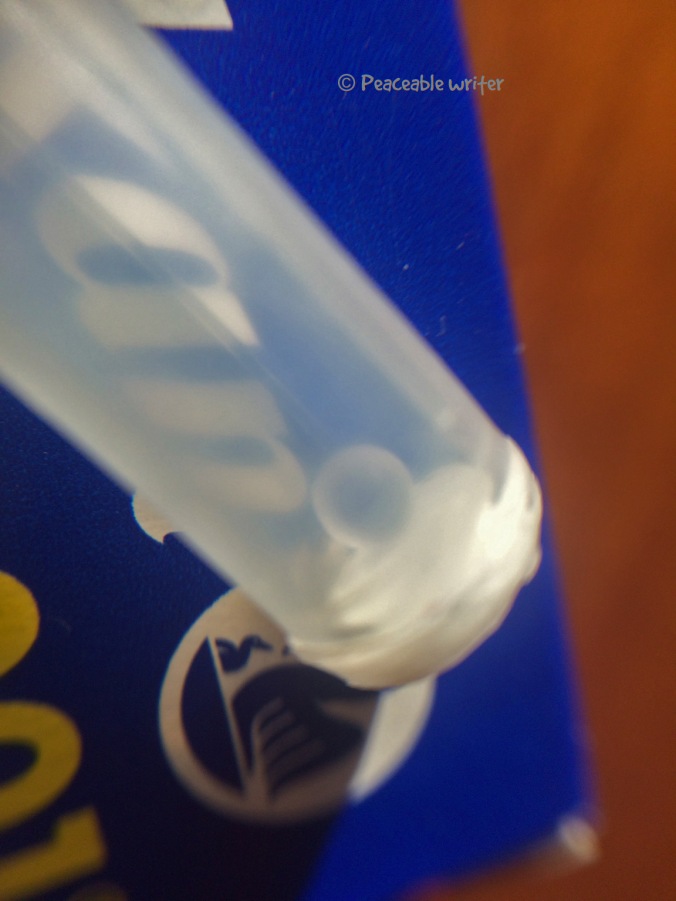
Pelikan cartridge with tiny ball at end of barrel
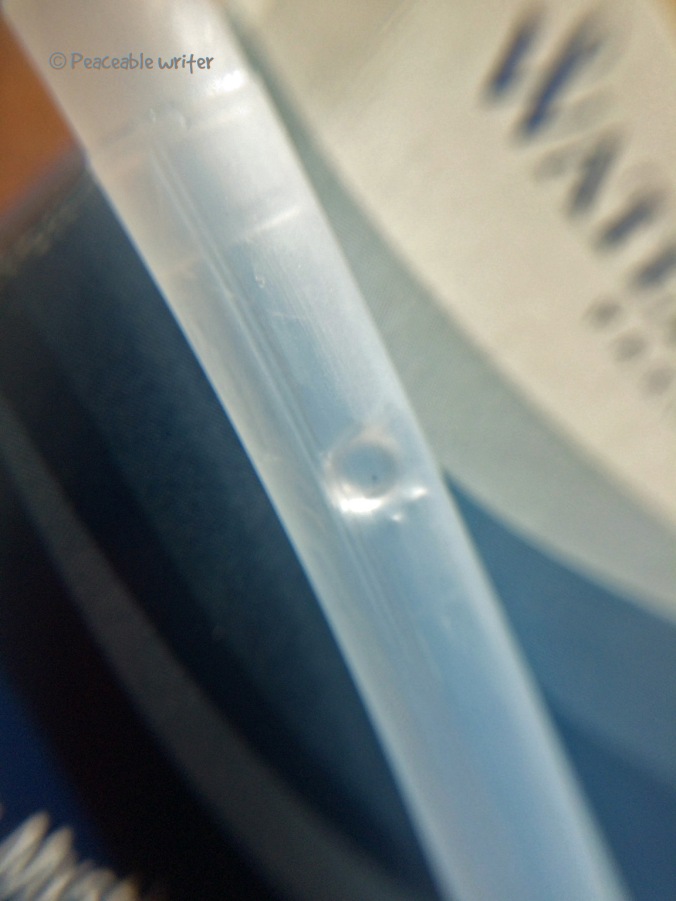
Waterman cartridge with tiny ball inside
You can re-use whatever ink cartridges you desire, fill ’em with whatever ink you love. Be aware not all plastic cartridges are created equally. Some may last a long time, and some might not fare well at all. The three cartridges I’ve selected for re-inking are pretty sturdy.
Refilling an ink cartridge delays sending the little plastic cart to the recycling bin. Hopefully for a long, long time.
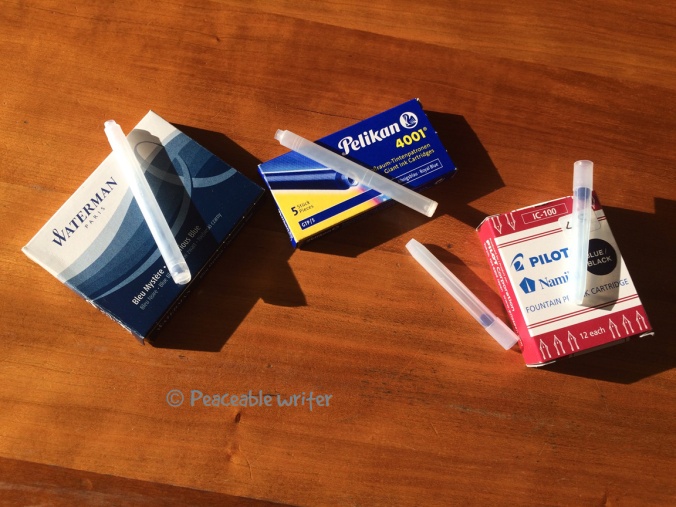
The Visconti Travelling Ink Pot
Lastly, most happily, a really nice solution I’ve found for carrying ink for converter pens is the Visconti Travelling Ink Pot. It holds 5ml of ink. In fact, the Visconti Ink Pot is the reason I still use a converter in my Platinum Kanazawa-Haku.
Deb Kinney’s 2004 article about the Ink Pot still stands as a wonderful source of detailed information. So read it, ay?
If you’re patient, you can find the Ink Pots for sale well below the high retail price tag. I’ve snagged two of these Viscontis. One is always filled with Pilot Blue-Black. The other is filled with whatever Sailor ink has taken my fancy—currently Sailor Doyou.
The Ink Pot works with a large range of pen brands and filling systems. Among my own fountain pens, the Visconti Ink Pot works with Edison, Bexley, Danitrio, Levenger True Writer, Namiki Sterling, Platinum Kanazawa-Haku, and even my Sheaffer Tuckaway.
The Pilot MYU and Decimo are too thin for the Ink Pot. The rubber gasket inside the Ink Pot can’t grab onto those pens.
My converter pens get an excellent ink fill via the Ink Pot; even using the puny Pilot Con-50.
The ink pot I’ve got is the “universal” model which has a rubber gasket the nib section fits into. The Visconti model is #533.
There are other older, discontinued models that are threaded, and fit certain pens. Here’s a list of some of those:
- 525 – Visconti Voyager, Ufizi and Alhambra
- 526 – Visconti Manhattan and Florentia
- 527 – Montblanc 146 and limited editions
- 528 – Montblanc 149 and Hemingway
- 529 – Pelikan M800 and limited editions
- 530 – Aurora 88, Optima and certain limited editions
- 531 – Omas Gentleman and full-size limited editions
These models still show up in the wild, so be sure, if you want the “universal” version, that you know which model you are buying.
I carry the Ink Pot in my pen roll. It fits just, uh, like a pen does. In fact, it’s about 5 1/4″ (13.34cm) in length:
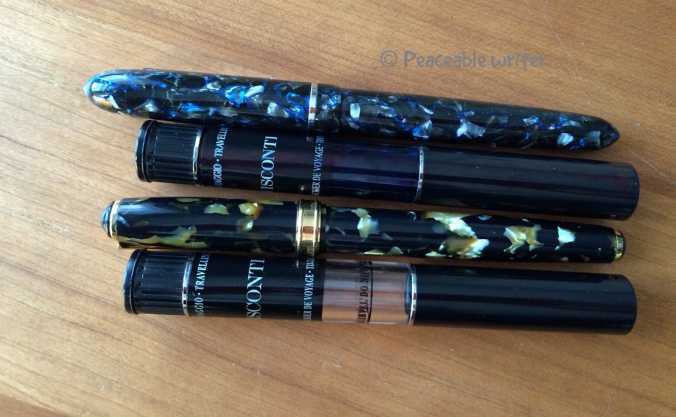
Top to bottom: Edison Menlo, Ink Pot, Levenger True Writer, Ink Pot
It’s important to follow the instructions for filling. Uh, for example, if you overfill the ink, and, uh, forget how to make an ink draw, an inky mess ensues. Honest. *ahem* So do take the time to read the instructions as often as needed.
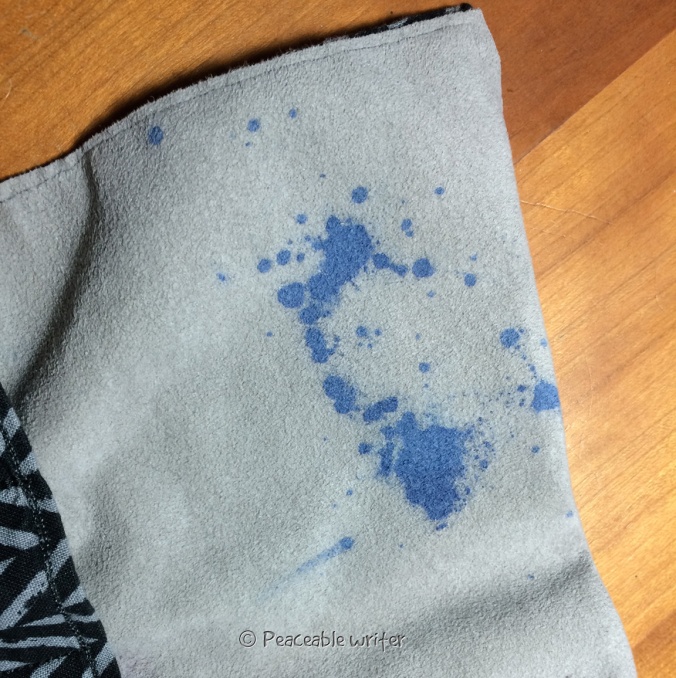
Pilot Blue-Black stain resulting from overfill of Visconti Ink Pot, and not paying attention to what I was doing…
That accident aside… the Visconti Ink Pot is a very clean, efficient method of inking a pen.
The Ink Pot comes with instructions for converter pens, piston, and power-filler or vacuum pens.
A confused friend once asked how I used the Visconti to fill an ED pen. Uh, it’s not for eyedropper pens. ED pens are their own ink pot, ay? The Visconti’s for converter, piston, and vacuum-filling pens.
Using the Visconti Travelling Ink Pot is simple. Observe (1min 40secs long):
There’s no excuse for running out of ink with two Visconti vials at my disposal.
Between the Visconti Travelling Ink Pot, and a couple of long, refillable ink cartridges, my converter pens are good to go for longer writing sessions than they have in the past.
Need More Information?
- Common Types of Fountain Pen Cartridges, Refill Finder, Glossary
- Let’s Reevaluate Converter Filling Fountain Pens, Brian Gray, Edison Pen, September 2014
- The Use and Care of the Visconti Ink Pot, Deb Kinney, March 2004
- Ink Facts, Pendemonium (great compatibility list)
- How to Refill Your Fountain Pen Cartridge, CollectionFreak, YouTube, December 2012 (Parker Quink in a Lamy pen)
- TWSBI – It’s All About the Ecosystem, Penucopia, October 2014 (TWSBI ink pot info)
- Pilot Converters, Crónicas Estilográficas, March 2011
- Pilot Con-50, Crónicas Estilográficas, May 2012
- Platinum Converters, Crónicas Estilográficas, February 2011
